Exotic
Aspila funebrana (Treitschke) (Tortricidae: Olethreutinae: Grapholitini)
Common names: plum fruit moth, red plum maggot
Synonyms: cerasana (Laspeyresia)
Aspila funebrana was formerly known as Grapholita funebrana until recently (Hu et al. 2023Hu et al. 2023:
Hu, G.-L., Brown, J.W., Heikkilä, M., Aarvik, L., Mutanen, M. 2023. Molecular phylogeny, divergence time, biogeography and trends in host plant usage in the agriculturally important tortricid tribe Grapholitini (Lepidoptera: Tortricidae: Olethreutinae). Cladistics. 39(5): 359-381.). It is often referred to as Cydia funebrana in older literature. Komai (1999)Komai (1999):
Komai, F. 1999. A taxonomic review of the genus Grapholita and allied genera (Lepidoptera: Tortricidae) in the Palaearctic region. Entomologica Scandinavica Supplement 55. 226 pp. provides a taxonomic history for the Grapholitini.
FWLFWL:
forewing length; the distance from the base of the forewing to the apex, including fringe : 4.0-7.5 mm
: 4.0-7.5 mm
Forewings are grayish brown with indistinct silvery-gray markings on the dorsumdorsum:
the lower (usually posterior) or inner margin 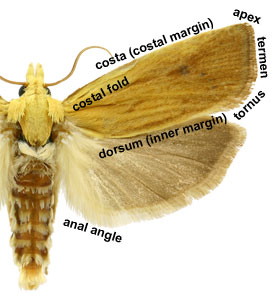 and around the poorly-defined ocellusocellus:
and around the poorly-defined ocellusocellus:
forewing pattern element - an ovoid region anterior to the tornus; adult head - a simple insect "eye" located dorsal to the compound eye 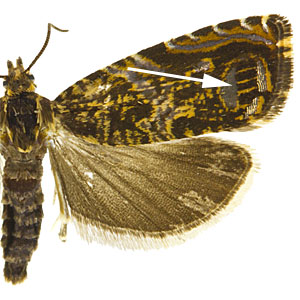 . Males lack a forewing costal foldforewing costal fold:
. Males lack a forewing costal foldforewing costal fold:
a flap or fold at the base of the forewing that contains specialized sex scales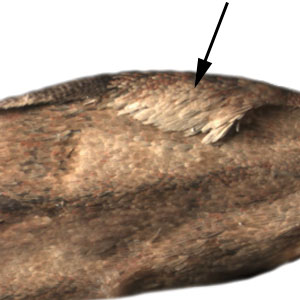 . Hindwings are brown.
. Hindwings are brown.
Male genitalia are characterized by the absence of an uncusuncus:
a sclerotized process which is fused to the posterodorsal margin of tergum IX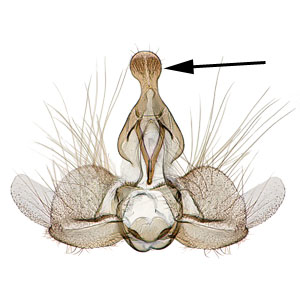 , a rounded cuculluscucullus:
, a rounded cuculluscucullus:
the distal portion of the male valva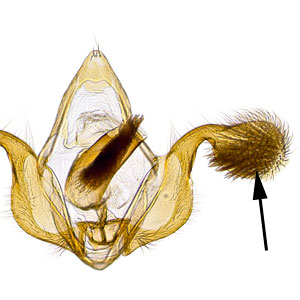 , and a thornlike projection on the ventralventral:
, and a thornlike projection on the ventralventral:
lower, to the bottom, on the under side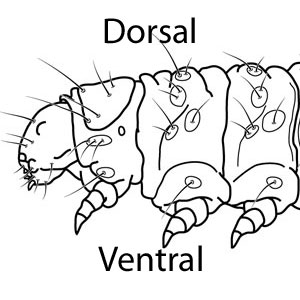 margin of the valvavalva:
margin of the valvavalva:
an appendage flanking the intromittent organ that is used to clasp the female during copulation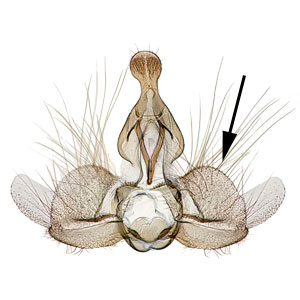 . Female genitalia are characterized by a rounded sterigmasterigma:
. Female genitalia are characterized by a rounded sterigmasterigma:
the sclerotized region surrounding the female ostium bursae 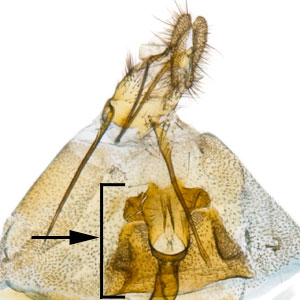 , an irregular sclerite in the ductus bursaeductus bursae:
, an irregular sclerite in the ductus bursaeductus bursae:
a membranous tube connecting the ostium bursae to the corpus bursae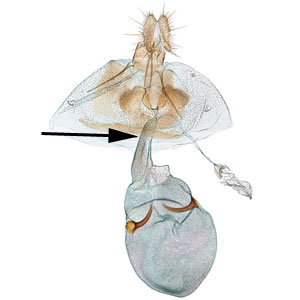 , and two long, curved, thorn-like signasignum:
, and two long, curved, thorn-like signasignum:
a sclerotized projection or patch on the interior of the corpus bursae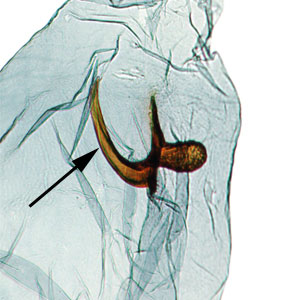 in the corpus bursaecorpus bursae:
in the corpus bursaecorpus bursae:
a dilated membranous sac at the anterior end of the bursa copulatrix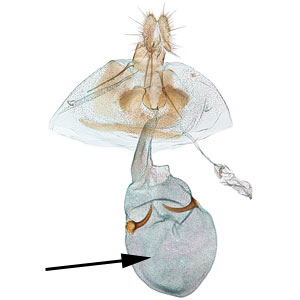 .
.
The following account is summarized from Swatschek (1958)Swatschek (1958):
Swatschek, B. 1958. Die larval systematik der wickler (Tortricidae und Carposinidae) aus dem zoologischen Institut der Universitat Erlangen. Akademie-Verlag, Berlin. 269 pp. [Abhandlungen zur larvalsystematik Insekten 3.] and Whittle (1984b).
Late instar larvae are approximately 9-12 mm in length with a bright reddish-pink abdomen. The head is dark brown and the prothoracic shieldprothoracic shield:
a sclerotized plate on the dorsal surface of the prothorax 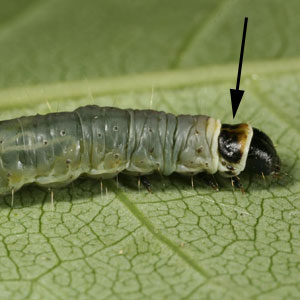 is yellowish brown. The anal shieldanal shield:
is yellowish brown. The anal shieldanal shield:
a sclerotized plate on the dorsal surface of the last abdominal segment (in larvae) 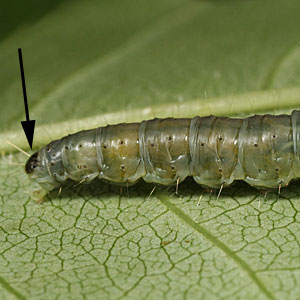 is light brown with dark mottling. An anal combanal comb:
is light brown with dark mottling. An anal combanal comb:
a toothed structure on the last abdominal segment used to eject frass away from the feeding larva; also termed "anal fork"  is present with 4-10 small teeth. Early instars are whitish with a black head and prothoracic shieldprothoracic shield:
is present with 4-10 small teeth. Early instars are whitish with a black head and prothoracic shieldprothoracic shield:
a sclerotized plate on the dorsal surface of the prothorax  .
.
Adults are similar to other species of Aspila, including A. molesta and A. tenebrosana; a genitalic dissection may be necessary to confirm species identity, especially if individuals are recovered from sticky traps. In A. molesta, males lack the thornlike projection off the ventralventral:
lower, to the bottom, on the under side margin of the valvavalva:
margin of the valvavalva:
an appendage flanking the intromittent organ that is used to clasp the female during copulation and the female sterigmasterigma:
and the female sterigmasterigma:
the sclerotized region surrounding the female ostium bursae  is laterally elongate with small posterolateralposterolateral:
is laterally elongate with small posterolateralposterolateral:
towards the rear and side; posterior and lateral  projections. In A. tenebrosana, the male valvavalva:
projections. In A. tenebrosana, the male valvavalva:
an appendage flanking the intromittent organ that is used to clasp the female during copulation is more elongate with the anal angleanal angle:
is more elongate with the anal angleanal angle:
on the hind wing, the angle nearest the end of the abdomen when the wings are expanded 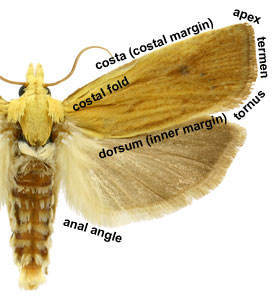 sharply pronounced and the female sterigmasterigma:
sharply pronounced and the female sterigmasterigma:
the sclerotized region surrounding the female ostium bursae  is large with triangular laterallateral:
is large with triangular laterallateral:
to the side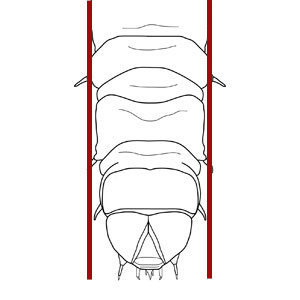 lobes.
lobes.
Pheromone traps using "Funemone" lures are commonly used to trap male A. funebrana . Alford (1978)Alford (1978):
Alford, D. V. 1978. Observations on the specificity of pheromone-baited traps for Cydia funebrana (Treitschke) (Lepidoptera: Tortricidae). Bulletin of Entomological Research. 68: 97-103. provided trapping data for "Funemone" traps operating in England over the course of three years. Non-target tortricids attracted to the "Funemone" pheromone include: Cnephasia stephensiana, Cnephasia sp., Celypha rufana, Hedya nubiferana, Pammene argyrana, Pammene fasciana, and Aspila tenebrosana. As the lure is not species-specific, it will also attract other species of Aspila, including Aspila molesta.
Larvae may appear similar to those of many other species of Aspila, Grapholita, and Cydia. Cydia pomonella larvae can be separated from A. funebrana by the absence of an anal fork. Other species of Aspila cannot be reliably separated from A. funebrana based solely on larval morphology. Chen and Dorn (2009) provide a molecular assay to distinguish A. funebrana larvae from similar species using a polymerase chain reaction-restriction fragment length polymorphism (PCR-RFLP) analysis.
The following account is summarized from Dickler (1991)Dickler (1991):
Dickler, E. 1991. Tortricid pests of pome and stone fruits, Eurasian species, pp. 435-452. In: van der Geest, L. P. S., Evenhuis, H. H. (eds.), Tortricid Pests: Their Biology, Natural Enemies, and Control. World Crop Pests, Vol. 5. Elsevier, Amsterdam..
Aspila funebrana completes 1-3 generations per year; two generations are most common over most of its range. Adults are present from late May to September.
First generation females lay eggs singly on fruitlets. Second generation females lay eggs near the base of maturing fruit. Larvae tunnel into the fruit and feed inside. Last instar larvae bore out of the fruit and overwinter in a cocoon spun on tree bark or in the soil. Pupation occurs the following spring. Larvae of the second generation cause the most damage to fruits such as plum that mature in mid- to late summer.
Aspila funebrana is one of the most important lepidopteran pests of fruit in Europe. Larvae can cause significant damage to apricot, cherry, peach, plum, and other Prunus species.
| Host plant | Host plant family | Reference(s) |
| Prunus armeniaca | Rosaceae | Bradley et al. 1979Bradley et al. 1979: Bradley, J. D., Tremewan, W. G., Smith, A. 1979. British Tortricoid Moths, Tortricidae: Olethreutinae. The Ray Society, London. 336 pp.; Sharma & Gupta 1987 |
| Prunus avium | Rosaceae | Bradley et al. 1979Bradley et al. 1979: Bradley, J. D., Tremewan, W. G., Smith, A. 1979. British Tortricoid Moths, Tortricidae: Olethreutinae. The Ray Society, London. 336 pp. |
| Prunus domestica | Rosaceae | Bradley et al. 1979Bradley et al. 1979: Bradley, J. D., Tremewan, W. G., Smith, A. 1979. British Tortricoid Moths, Tortricidae: Olethreutinae. The Ray Society, London. 336 pp. |
| Prunus fruticosa | Rosaceae | Komai 1999Komai 1999: Komai, F. 1999. A taxonomic review of the genus Grapholita and allied genera (Lepidoptera: Tortricidae) in the Palaearctic region. Entomologica Scandinavica Supplement 55. 226 pp. |
| Prunus japonica | Rosaceae | Bradley et al. 1979Bradley et al. 1979: Bradley, J. D., Tremewan, W. G., Smith, A. 1979. British Tortricoid Moths, Tortricidae: Olethreutinae. The Ray Society, London. 336 pp. |
| Prunus maximowiczii | Rosaceae | Komai 1999Komai 1999: Komai, F. 1999. A taxonomic review of the genus Grapholita and allied genera (Lepidoptera: Tortricidae) in the Palaearctic region. Entomologica Scandinavica Supplement 55. 226 pp. |
| Prunus persica | Rosaceae | Byun et al. 1998Byun et al. 1998: Byun, B., Bae, Y., Park, K. 1998. Illustrated catalogue of Tortricidae of Korea (Lepidoptera). In : Park, K.-T. (ed.), Insects of Korea [2]. Korea Research Institute of Bioscience and Biotechnology amp; Center for Insect Systematics. 317 pp. |
| Prunus spinosa | Rosaceae | Bradley et al. 1979Bradley et al. 1979: Bradley, J. D., Tremewan, W. G., Smith, A. 1979. British Tortricoid Moths, Tortricidae: Olethreutinae. The Ray Society, London. 336 pp.; Byun et al. 1998Byun et al. 1998: Byun, B., Bae, Y., Park, K. 1998. Illustrated catalogue of Tortricidae of Korea (Lepidoptera). In : Park, K.-T. (ed.), Insects of Korea [2]. Korea Research Institute of Bioscience and Biotechnology amp; Center for Insect Systematics. 317 pp. |
| Prunus sp. | Rosaceae | Bradley et al. 1979Bradley et al. 1979: Bradley, J. D., Tremewan, W. G., Smith, A. 1979. British Tortricoid Moths, Tortricidae: Olethreutinae. The Ray Society, London. 336 pp.; Kasumyan & Mnatsakanyan 1987 |
| Pyrus ussuriensis | Rosaceae | Danilevsky & Kuznetzov 1968 |
| Rosa davurica | Rosaceae | Danilevsky & Kuznetzov 1968 |
View full screen host table here
A native of Europe, Aspila funebrana has spread to most other fruit-growing regions of the Palearctic. It is currently present from Europe and northern Africa across Asia Minor and Central Asia to China, Korea, and Japan.
Fig. 5: Fvlamoen